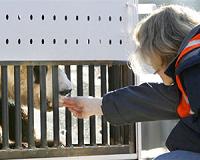| . |  |
. |
Ottawa (AFP) July 9, 2010 Canada's patchwork of parks must be connected, and more, bigger parks must be created in order to protect the habitats of large roaming animals, said a report Friday. Canada boasts more than 3,500 protected areas, including 42 national parks. But the Canadian Parks and Wilderness Society (CPAWS) in its report warned that several species are at risk of dying out because their designated confines are too small. "In Canada we have one of the best opportunities left in the world to create big parks that can protect species that need large areas of wilderness to survive," said CPAWS executive director Eric Hebert-Daly. "Bigger, better managed parks, and more of them, are needed if parks are to fulfill their critical role in protecting Canada's wildlife." In the past year, the government established the new Gwaii Haanas National Marine Conservation Area off the coast of British Columbia, where orca whales feed. Ottawa also announced it would create new parks to protect wild horses on Sable Island, Nova Scotia and in the Mealy Mountains of Newfoundland, where a herd of woodland caribou roam. But CPAWS said this falls short. The non-profit group, which played a lead role in establishing two-thirds of Canada's protected wilderness spaces over the past five decades, prescribed creating even more parks and expanding existing park boundaries. It also called for the restoration of "wildlife movement corridors" to allow animals to roam between protected areas, for interbreeding and adapting to environmental changes. "Many of our parks, particularly in southern Canada, are small islands of nature in developed landscapes," the report noted. "And evidence is growing that for parks to effectively protect wildlife, particularly those species that range over large areas, they need to protect big areas of habitat and be connected together into networks of protected lands and waters." As examples, the report blamed "habitat fragmentation" for grizzly bear deaths and for the decline of woodland caribou in Banff National Park until the last five caribou were wiped out in an avalanche last year. Grizzly bears need "an abundance of secure habitat (away from roads and trails)" to survive, the report said. A male grizzly bear can roam over 1,000 square kilometers (385 square miles) to find all the food, shelter, and mates he needs in his lifetime. Banff 's 6,641 square kilometers (2,564 square miles) is "not enough space for a healthy, viable population to survive," it said. Six grizzly bears were killed by trains outside the park since 2007 due to "a lack of effective movement corridors." Banff is connected to Jasper National Park to the north, and to protected areas in Kananaskis Country to the south, but "connecting this complex of protected areas further south is key to the success of this species." The report was also critical of a proposed Tursujuq Provincial Park's boundaries in Quebec's far north for not including the majority of the habitat of the world's only harbor seals that live permanently in freshwater. And the development of wineries, retirement homes, small ranches and golf courses near a proposed South Okanagan-Similkameen National Park Reserve in British Columbia is encroaching on the habitat of one-third of the province's species at risk. In Manitoba province, meanwhile, a recent hunting ban in and near Nopiming Provincial Park is hoped will boost the faltering number of moose that move in and out of the park.
Share This Article With Planet Earth
Related Links Darwin Today At TerraDaily.com
 China to launch global search for panda keepers
China to launch global search for panda keepersChengdu, China (AFP) July 8, 2010 Yang Gangkun calls out to two pandas lying on their backs chewing bamboo. They push themselves up and slowly amble over for their morning workout in a breeding centre in southwest China. The 24-year-old is a panda keeper at the Chengdu Panda Base in Sichuan province - which will soon offer contestants from around the world a chance to help look after the endangered animals for a month. ... read more |
|
| The content herein, unless otherwise known to be public domain, are Copyright 1995-2010 - SpaceDaily. AFP and UPI Wire Stories are copyright Agence France-Presse and United Press International. ESA Portal Reports are copyright European Space Agency. All NASA sourced material is public domain. Additional copyrights may apply in whole or part to other bona fide parties. Advertising does not imply endorsement,agreement or approval of any opinions, statements or information provided by SpaceDaily on any Web page published or hosted by SpaceDaily. Privacy Statement |